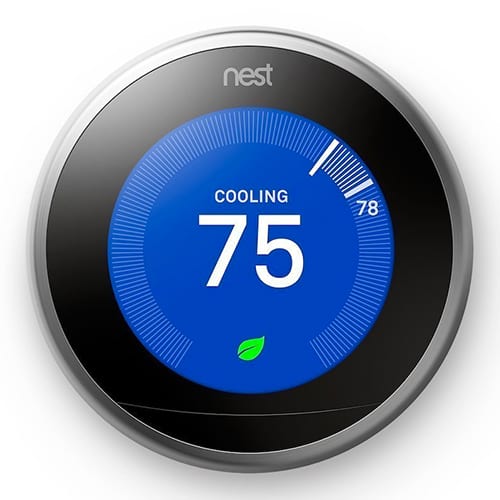 Nest Learning Thermostat
Nest Learning Thermostat
- Works with most 24V thermostats
- Sports a large, easy-to-read display
- Works with most 24V thermostats
- Sports a large, easy-to-read display
- Has subtle frosted glass display
- Costs less for similar features
The Bottom Line: Google Nest Thermostats Save Time, Energy, and Cash
Google’s Nest Thermostat changed the energy savings game when it debuted in 2011. Now in its third generation, it still makes heating and cooling in your house a breeze. The more you interact with the Nest Learning Thermostat or Nest Thermostat E, the faster it will learn what you like and adjust accordingly.
This learning thermostat is expensive initially but saves money and energy every month with features like auto-away and auto-schedule. At the end of the month, it generates an energy report highlighting how much you saved and how to improve your bill even more. Can your old thermostat do that?
Pros
- Learns your preferences the more you use it
- Delivers monthly energy reports
- Adjusts from your phone whether you’re home or away
Cons
- Steep initial price
- Installation is easy but takes a while
- Not compatible with every home
How We Reviewed the Google Nest Thermostat
We got our hands on a Nest Learning Thermostat, and we took notes on installation and standout features (good and bad). This isn’t the first smart thermostat we’ve reviewed, so we compared it to similar products to see if Nest really is best. We also checked other reviews and installation videos to see how this learning thermostat worked for others.
We combined everything we learned about the device, its competitors, and customer reviews to create this comprehensive guide to both versions of Google’s Nest Thermostat. Check out our methodology to learn more about how we conduct reviews on SafeWise.
Similarities and Differences
The Nest Learning Thermostat and Nest Thermostat E have many of the same features, but you can save a little cash with your initial purchase with the latter. Just be sure to check your existing system. Depending on what you have, you may have to opt for the more expensive Google Nest Thermostat because it’s compatible with more HVAC systems.
| Prices |
| Auto-Away |
| Auto-Schedule |
| Monthly Energy Report |
| Ring Color Options |
| High-Res Display |
| Learn More |
| Nest Learning Thermostat | Nest Thermostat E |
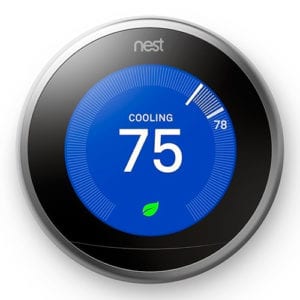 |
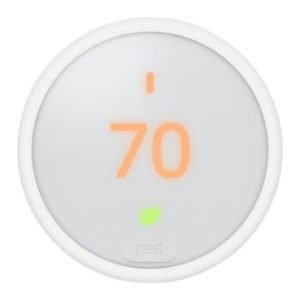 |
| $249.99 | $169.99 |
| Yes ✓ |
Yes ✓ |
| Yes ✓ |
Yes ✓ |
| Yes ✓ |
Yes ✓ |
| Yes ✓ |
No X |
| Yes ✓ |
No X |
| View on Kohl's | View on Kohl's |
Info current as of 05/13/20. Offers and availability may vary by location and are subject to change.
The two versions of the Nest Thermostat have the same software and capabilities—the differences are mostly cosmetic.
Similarities
You can control both thermostats manually, through the Nest app, or with your voice using Amazon Alexa or Google Home. They can both sense sunlight, activate fans after turning off the AC, and adjust remotely.
And both Nest Thermostats have the same energy-saving features.
- Auto-away changes the temperature when you leave home.
- Auto-schedule learns your preferences and schedules accordingly.
- Monthly report shows how you used energy throughout the month.
- Nest leaf indicates energy-saving temperatures.
Differences
The Nest Learning Thermostat is larger, has more wire ports to boost compatibility, and comes in seven finishes to match your decor.
Although the Nest E comes only in white, its subtle frosted glass helps it blend in with home interiors. But it’s difficult to read the display from across the room.
And because the Nest E is smaller, it can’t fit as many wire ports—making it compatible with only 85% of 24V systems. Depending on your existing system, you may have to opt for the 3rd generation Google Nest Thermostat for compatibility reasons.
If readability and design are worth extra cash, the Nest Learning Thermostat is for you. On the other hand, the Nest Thermostat E has the same features for less but without the wow factor.
Equipment and Smart Features
Both versions of Nest are loaded with onboard sensors that make them smarter than the average thermostat. The sensors read temperature, light, and motion to make adjustments based on your preferences and schedule.
Both Google Nest Thermostats learn your routine and adjust according to your comfort preferences and energy conservation goals.
If the thermostat senses lots of sunlight in your room, it saves energy by letting the natural light do the work. The thermostat’s internal clock adjusts the temperature based on morning and nightime temperatures too.
Auto-Away and Auto-Schedule
Nest’s connection to your smartphone triggers an auto-away feature that adjusts the thermostat to the best temperature for conserving energy. Whether you’re on vacation or around the block, the auto-away feature adjusts the thermostat to save the most energy and money.
The auto-schedule remembers when you regularly come and go and creates an estimated schedule for your home’s temperature. It takes about a week for the thermostat to learn your routine.
Feeling impatient? You can adjust it manually in the Nest App at regular intervals for the first few days to program the schedule.
The Nest Leaf
The iconic Nest leaf appears on the thermostat’s display when you choose an energy-saving temperature. Think of it like a goal temperature for the best conservation results. It may leave you a little chillier in winter or warmer in the summer.
Monthly Energy Report
One of our favorite features the Nest Learning Thermostat and Nest Thermostat E offer is a monthly energy report. Nest sends an email full of information about energy usage, what’s using it, and how it compares to previous months.
Because this smart thermostat actually learns, the report becomes sharper and more helpful each month.
Third-Party Compatibility
Both Google Nest Thermostats connect to smart hubs like Amazon Echo and Google Home. It takes only a few minutes to connect Nest to your Google Home. To connect Alexa, look up the Google Nest skill to sync your devices. Once connected, you can change the thermostat and set schedules with your voice.
Nest Thermostats also connect to home security systems like Brinks and SimpliSafe. If you have other Nest devices like Nest cameras or the Nest Secure system, you can set automations that make your home smarter.
Farsight
The Nest Learning Thermostat features Farsight, a motion sensor that lights the display when you’re nearby. The wake screen is up to you too. Choose from a digital or analog clock, the current weather, or the home temperature.
Installing Nest
It takes only a screwdriver and some patience to install a Nest Thermostat. Before you buy, make sure your current thermostat is compatible with Nest’s wiring.
What’s in the Box
- Display
- Base
- Trim plate
- Screws
- Instructions
- Wire labels
Start by turning off your HVAC system, then remove the old thermostat. Label the wires with the included wire labels and place the base and faceplate on the wall. Both Nest models have a level to keep things straight.
Now slide the wires into the labeled tabs of the base. Once they’re all fitted, screw the base and faceplate to the wall and snap on the display.
From here it’s all digital. You’ll use the Nest Thermostat display to connect to Wi-Fi and the app. Then select language and temperature settings. If you want to connect to your Amazon Alexa or Google Home, that adds a little more time but saves stress later.
Google Home: If you sign into Nest using your Google account, your Nest Thermostat should pair to Google Home automatically. Otherwise, it takes only a few steps to connect Nest to Google Home.
Amazon Alexa: Alexa can learn a skill that connects to Nest products like the smart thermostat. Just download the skill from Amazon and you’re good to go!
How Google Nest Stacks Up
| Price |
| Control from App |
| Away Mode |
| Monthly Report |
| Learn More |
| Nest Learning Thermostat | Ecobee 4 | Honeywell Lyric |
 |
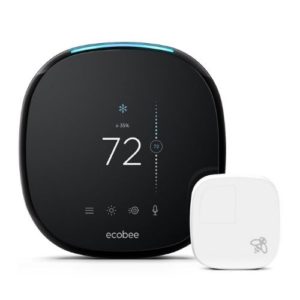 |
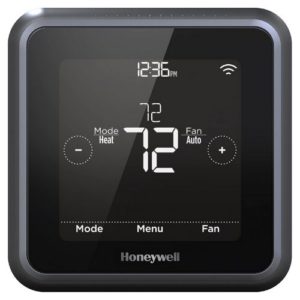 |
| $199.00 | $189.00 | 112.99* |
| Yes ✓ |
Yes ✓ |
Yes ✓ |
| Yes ✓ |
Yes ✓ |
Yes ✓ |
| Yes ✓ |
No X |
No X |
| View on Kohl's | View on Walmart | View on Amazon |
Info current as of 05/13/2020. Offers and availability may vary by location and are subject to change.
*Amazon.com price as of 05/13/2020 at 01:35 p.m. (MT). Read full disclaimer.
The best smart thermostats share similar automation features that give you control from afar—like a mobile app, automatic scheduling, and self-adjusting technology. Installation is the same across the board too.
Nest’s learning thermostat stands out with its sleek look, monthly energy report, and long-term savings.
If you’d rather save money up front, brands like Ecobee and Honeywell have products that give Nest a run for its money. But if you want a thermostat with style and a couple extra features, Google Nest is where it’s at.
Before You Buy Google Nest Thermostat
Before jumping into a big purchase like a smart thermostat, there are two things you should consider.
First: compatibility. Check your current thermostat to see if it’s compatible with Nest or any other smart thermostat you’re interested in. Compatibility is based on voltage, so look for a number between 20V to 30V. Many thermostats land around 24V. Nest has a compatibility checker to make the process easier.
Second: your energy bill. There’s nothing wrong with wanting to save energy, but make sure you’re spending enough on your current bill to warrant a big purchase like this. On average, Nest Thermostats save up to $145 per year after a couple years, but this varies for individuals.1 Energy companies across the country also offer rebates up to $100 to customers who install a smart thermostat.
Final Word about Nest Thermostats
With Nest, it takes money to save money, but you can find discounts through your local energy provider if you know where to look.
While it’s expensive up front, these smart thermostats are an investment that can save you hundreds of dollars over the years. It pays for itself in convenient features and sends reports on how to save even more. It doesn’t hurt that this smart thermostat is beautifully designed either.
And while you can find similar features in other smart thermostats, its connectivity to smart speakers, security systems, and other products like Nest cams is unmatched.
Nest Thermostat FAQ
Do Nest thermostats really save money?
While it varies by household and how you use your Nest Thermostat, independent studies have shown up to 12% savings on heating and up to 15% on cooling.1
Check with your local energy provider to see if you can get a rebate for your new smart thermostat. We’ve seen discounts up to $100 that help you save on the thermostat itself.
Is there a monthly fee for Nest thermostat?
Nope! Unlike Nest cams or the Nest Secure system, there’s no monthly subscription tied to Nest Thermostats. But monthly fees are required for Nest Aware, an optional service that boosts features.
Can I install a Nest Thermostat myself?
Yes. It takes about an hour to go through the hardware and software setups, but even new DIY-ers can handle installing a Nest Thermostat. If you’d still prefer professional installation, you can find one through Nest.
What’s the best temperature to set my thermostat at?
The best temperature changes depending on the season and when you’re home. During the cooler months, set your thermostat to around 68° F while you’re home during the winter and 78° F during the warmer months when you’re home. If you go on vacation during cooler months, set it to 55° F to keep your energy usage low while you aren’t using the thermostat.2
Sources (H3)
- Google Nest Help, “Learn about Nest Thermostats before You buy”
- Energy.gov, “Thermostats”
Disclaimer
*Amazon.com list price as of 05/13/2020 02:10 (MT). Product prices and availability are accurate as of the date/time indicated and are subject to change. Any price and availability information displayed on Amazon at the time of purchase will apply to the purchase of this product. Safewise.com utilizes paid Amazon links.
Certain content that appears on this site comes from Amazon. This content is provided “as is” and is subject to change or removal at any time.
The post Nest Thermostat Review appeared first on SafeWise.

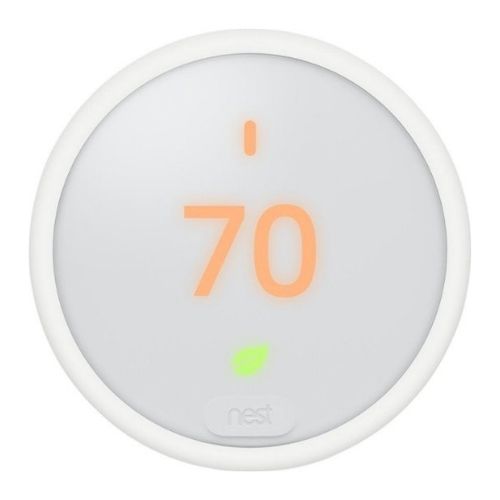
No comments:
Post a Comment